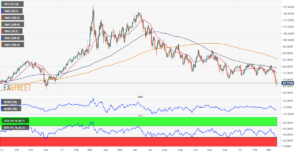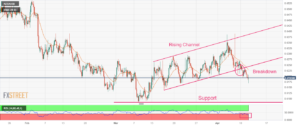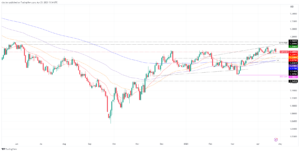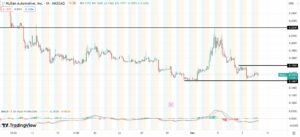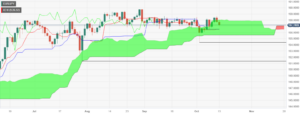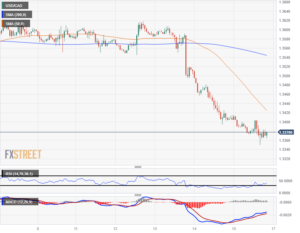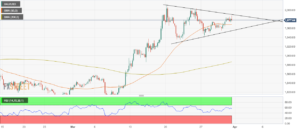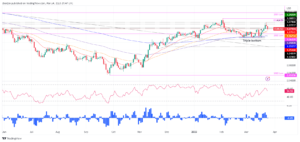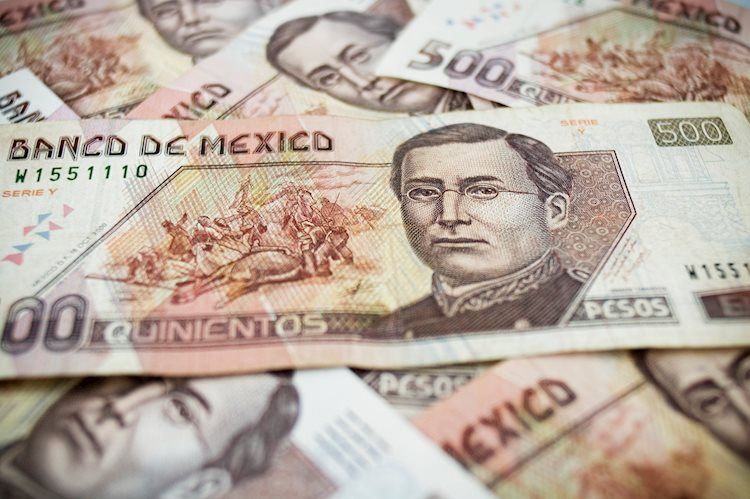
- Mexican Peso remains defensive, as it registered over 0.70%% weekly loss vs. the US Dollar.
- Mexico’s August Retail Sales mixed as the economy decelerates.
- Geopolitical risks cap Peso’s gains, including tensions in the Middle East and US military base attacks.
Mexican Peso (MXN) stays firm versus the US Dollar (USD) as Wall Street closes, though it would end Friday’s session in the green, but unable to reverse weekly losses of around 0.70%. The reason behind the Peso weakness was the sour sentiment, which bolstered the appetite for safe-haven peers. At the time of writing, the USD/MXN is trading at around 18.24, down 0.49%, although Retail Sales from Mexico showed the economy feels the pain of higher interest rates set by the Bank of Mexico (Banxico).
Mexico’s National Statistic Agency, known as INEGI, revealed August Retail Sales plunged on monthly figures but expanded on a yearly basis, though showing signs of a deceleration. Comments made by the US Federal Reserve (Fed) Chair Jerome Powell on Thursday suggest the US central bank might keep rates unchanged at the upcoming November meeting, keeping the door open for December’s meeting. The overall effect of Powell’s speech was some short-term weakness for the Dollar.
Recently, Atlanta’s Fed President Raphael Bostic stated that along with opening the door for a rate cut in 2024. In the meantime, Cleveland’s Fed President Loretta Mester said the Fed is at or near peak rate hike cycle, adding that the US central bank would be data defendant in the next monetary policy meeting.
In the meantime, geopolitical risks remain high as Israel continues its offensive against Hamas. At the same time, the United States (US) said its military bases in Iraq and Syria are increasingly coming under attack.
Daily Digest Market Movers: Mexican Peso fights back, pushing the pair below 18.30
- Mexico’s August Retail Sales plunged -0.4% MoM, missing estimates of 0%, while annually expanding by 3.2%. This was below forecasts of 4.4% and trailed July’s 5.1%.
- IOAE portrays the Mexican economy growing at a 3.12% YoY pace.
- US Initial Jobless Claims for the week ending October 14 rose by 198K, below estimates and previous week data, each at 212K and 211K, respectively.
- US Existing Home Sales rose by 3.96M in September, below August’s 4.04M, a -2% contraction.
- US Building Permits plummeted -4.4% in September, compared to last month’s 6.8% increase.
- Housing Starts for the same period previously mentioned rose by 7%, exceeding August’s -12.5% drop.
- Mexico’s GDP in 2023 is expected to hit 3.2%, according to the World Bank and the International Monetary Fund.
- Mexico’s Industrial Production (IP) for August improved by 5.2% YoY, exceeding forecasts of 4.6% and July’s 4.8% increase.
- Monthly, IP in Mexico rose 0.3%, as expected, but trailed the previous 0.5% reading.
- Mexico’s Consumer Price Index (CPI) grew by 4.45% YoY in September, slightly below the 4.47% estimated.
- The core CPI inflation in Mexico stood at a stickier 5.76% YoY, as widely estimated, but has broken below the 6.00% threshold.
- The Bank of Mexico (Banxico) held rates at 11.25% in September and revised its inflation projections from 3.50% to 3.87% for 2024, above the central bank’s 3.00% target (plus or minus 1%).
Technical Analysis: Mexican Peso gathers momentum while USD/MXN buyers anticipate pullback before the next rise
The USD/MXN is upward biased, though the ongoing rally was capped short of testing the latest cycle high, the October 6 high, of 18.48, which opens the door for a pullback.
The exotic pair could drop toward 18.00 before testing the 20-day Simple Moving Average (SMA) at 17.91. A drop below that could put at risk the uptrend, as the bull’s latest line of defense is likely to be the 200-day SMA at 17.74.
On the other hand, if the pair aims higher and buyers reclaim 18.48, that would put the 18.50 figure into play, followed by the 19.00 mark.
Interest rates FAQs
Interest rates are charged by financial institutions on loans to borrowers and are paid as interest to savers and depositors. They are influenced by base lending rates, which are set by central banks in response to changes in the economy. Central banks normally have a mandate to ensure price stability, which in most cases means targeting a core inflation rate of around 2%.
If inflation falls below target the central bank may cut base lending rates, with a view to stimulating lending and boosting the economy. If inflation rises substantially above 2% it normally results in the central bank raising base lending rates in an attempt to lower inflation.
Higher interest rates generally help strengthen a country’s currency as they make it a more attractive place for global investors to park their money.
Higher interest rates overall weigh on the price of Gold because they increase the opportunity cost of holding Gold instead of investing in an interest-bearing asset or placing cash in the bank.
If interest rates are high that usually pushes up the price of the US Dollar (USD), and since Gold is priced in Dollars, this has the effect of lowering the price of Gold.
The Fed funds rate is the overnight rate at which US banks lend to each other. It is the oft-quoted headline rate set by the Federal Reserve at its FOMC meetings. It is set as a range, for example 4.75%-5.00%, though the upper limit (in that case 5.00%) is the quoted figure.
Market expectations for future Fed funds rate are tracked by the CME FedWatch tool, which shapes how many financial markets behave in anticipation of future Federal Reserve monetary policy decisions.
- SEO Powered Content & PR Distribution. Get Amplified Today.
- PlatoData.Network Vertical Generative Ai. Empower Yourself. Access Here.
- PlatoAiStream. Web3 Intelligence. Knowledge Amplified. Access Here.
- PlatoESG. Carbon, CleanTech, Energy, Environment, Solar, Waste Management. Access Here.
- PlatoHealth. Biotech and Clinical Trials Intelligence. Access Here.
- Source: https://www.fxstreet.com/news/mexican-peso-recovers-ground-against-us-dollar-despite-mexicos-weaker-retail-sales-risk-off-impulse-202310201557
- :has
- :is
- $UP
- 11
- 14
- 17
- 19
- 2%
- 2023
- 2024
- 24
- 28
- 32
- 33
- 50
- 91
- a
- above
- According
- adding
- against
- agency
- aims
- along
- Although
- an
- analysis
- and
- Animate
- Annually
- anticipate
- anticipation
- appetite
- ARE
- around
- AS
- asset
- At
- attack
- Attacks
- attempt
- attractive
- AUGUST
- average
- back
- Bank
- Banks
- base
- basis
- BE
- because
- before
- behind
- below
- biased
- boosting
- borrowers
- Broken
- Building
- but
- buyers
- by
- cap
- case
- cases
- Cash
- central
- Central Bank
- Central Banks
- Chair
- Changes
- charged
- claims
- Closes
- CME
- coming
- comments
- compared
- consumer
- consumer price index
- content
- continues
- contraction
- Core
- core inflation
- Cost
- could
- country’s
- CPI
- Currency
- Cut
- cycle
- data
- decisions
- Defense
- defensive
- depositors
- Digest
- Dollar
- dollars
- Door
- down
- Drop
- each
- East
- economy
- effect
- end
- ending
- ends
- ensure
- estimated
- estimates
- example
- existing
- Exotic
- expanded
- expanding
- expectations
- expected
- Falls
- FAQ
- Fed
- fed funds rate
- Federal
- federal reserve
- fights
- Figure
- Figures
- financial
- Financial institutions
- Firm
- followed
- FOMC
- For
- forecasts
- Friday
- from
- fund
- funds
- future
- Gains
- GDP
- generally
- geopolitical
- Global
- Gold
- Green
- grew
- Growing
- hamas
- hand
- Have
- headline
- Held
- help
- High
- higher
- Hike
- Hit
- holding
- Home
- How
- HTTPS
- if
- improved
- in
- Including
- Increase
- increasingly
- index
- industrial
- Industrial Production
- inflation
- inflation rate
- influenced
- initial
- instead
- institutions
- interest
- Interest Rates
- International
- international monetary fund
- into
- investing
- Investors
- IP
- iraq
- Israel
- IT
- ITS
- jerome
- jerome powell
- jobless claims
- jpg
- Keep
- keeping
- known
- Last
- latest
- LEND
- lending
- likely
- LIMIT
- Line
- Loans
- loss
- losses
- lower
- lowering
- made
- make
- mandate
- many
- mark
- Market
- Markets
- May..
- means
- meantime
- meeting
- meetings
- mentioned
- Mexico
- Middle
- Middle East
- might
- Military
- missing
- mixed
- module
- mom
- Momentum
- Monetary
- Monetary Policy
- money
- monthly
- more
- most
- Movers
- moving
- moving average
- National
- Near
- next
- normally
- November
- october
- October 6
- of
- offensive
- on
- ongoing
- open
- opening
- opens
- Opportunity
- or
- Other
- over
- overall
- overnight
- Pace
- paid
- Pain
- pair
- Park
- Peak
- peers
- period
- permits
- Peso
- Place
- placing
- plato
- Plato Data Intelligence
- PlatoData
- Play
- plus
- policy
- portrays
- Powell
- Powell’s
- president
- previous
- previously
- price
- Production
- projections
- pullback
- pushes
- Pushing
- put
- raising
- rally
- range
- Rate
- Rate Hike
- Rates
- Reading
- reason
- registered
- remain
- remains
- Reserve
- respectively
- response
- Results
- retail
- Retail Sales
- Revealed
- reverse
- Rises
- Risk
- risks
- ROSE
- s
- Said
- sales
- same
- Savers
- sentiment
- September
- session
- set
- shapes
- Short
- short-term
- showed
- showing
- Signs
- Simple
- since
- SMA
- some
- speech
- Stability
- stands
- starts
- stated
- street
- Strengthen
- substantially
- suggest
- Syria
- Target
- targeting
- tensions
- Testing
- that
- The
- the Fed
- The US Federal Reserve
- the world
- their
- they
- this
- though?
- threshold
- thursday
- time
- to
- tool
- toward
- Trading
- unable
- under
- upcoming
- uptrend
- upward
- us
- US banks
- US Central Bank
- US Dollar
- US Federal
- us federal reserve
- US military
- USD
- usually
- Versus
- View
- vs
- Wall
- Wall Street
- was
- weakness
- week
- weekly
- weigh
- which
- while
- widely
- with
- world
- World Bank
- would
- writing
- yearly
- yet
- zephyrnet

